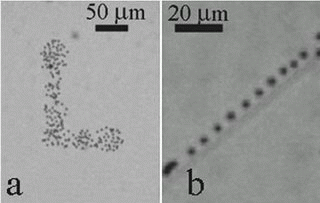March 16, 2007 feature
Magnetic particles act as ink in new printer

By using a laser beam to focus and push particles against a substrate, scientist Lars Helseth of Nanyang Technological University in Singapore has designed and built a unique type of colloidal printer. Taking advantage of the electrical and paramagnetic properties of tiny beads, Helseth’s printer provides a new printing method that may have applications in printing chemical and biological patterns.
“To the best of my knowledge, this is the first printer based on the laser-pushing of colloids,” Helseth told PhysOrg.com. “I got the idea after reading about some fascinating experiments done by Arthur Ashkin and coworkers in the 1970s and 1980s. He demonstrated how one can push colloids around using optical forces. I have recently been working a lot with methods for trapping colloidal particles using nanomagnets, and during the last year been able to combine optical and magnetic tweezers in order to probe small (femtonewton) forces in particle systems.”
Based on his experience with this system, Helseth decided to use the trapping methods to create the colloidal printer, which is based on a combination of optical forces and paramagnetic beads. In the setup, a green focused optical laser beam with a wavelength of 532 nm transports paramagnetic polystyrene beads (or colloids) from a reservoir to a functionalized glass substrate.
The polystyrene beads, which have a diameter of slightly less than 3 micrometers, get their paramagnetic behavior from nanoscale iron oxide grains on the beads. Helseth put the beads on a glass surface which had been negatively charged by a process of rinsing in chemicals and water. The negatively charged beads fell to the bottom of the glass substrate due to gravity, without attaching to the glass.
By using an objective lens of a microscope to focus the laser beam, Helseth created a focal spot of about 30 micrometers. With this light spot, and about 30 mW of power, the laser could push a single bead against gravity up to a substrate.
Once the particles reached the vicinity of the substrate, they had to be attached. For this entrapment, Helseth experimented with two different methods based on chemical coating and the magnetic charge of the beads, respectively. In the first method, Helseth used a chemical rinsing process to apply a nanometer-thick layer of positively charged chemicals on the upper glass substrate. The laser beam guided the beads to form patterns, although this method of control was limited by the diameter of the laser beam and possible disturbances.
In the second method for attaching particles to a substrate, Helseth applied a thin magnetic pattern to the upper substrate. When the beads traveled to within 8 micrometers of the top substrate, they became trapped by the magnetic line and pulled to the pattern to an accuracy of about 200 nanometers.
The printing speed in this first colloidal set-up was quite slow, with an average printing speed of about 1 micrometer per second (or a few minutes per average-sized letter). In general, Helseth explains, the printing speed is limited by the speed at which the colloids move from the lower to the upper substrate as well as the distance between the two substrates. However, the printer has its own advantages.
“By increasing the laser power (thus increasing the optical force and therefore also the speed of the colloids in the liquid) and decreasing the separation between the two substrates, I expect that it should be possible to increase the printing speed to several millimeters per second,” Helseth said. “Although this is much slower than current desktop printers, the proposed colloidal printer is the first one using optical forces. Moreover, the printer has a high resolution (about 200 nm or better) and may target niches not easily accessible by commercial printers.”
Some of these niches may include the high-res printing of chemical and biomolecular patterns with the use of proteins, Helseth suggests.
“The nice thing about the paramagnetic colloids I have used is that they come with all kinds of coatings (i.e. thin layers surrounding them as an outer shell) for specific protein, DNA and cell isolation,” he said. “Many of these colloids have a net negative electrostatic charge, and can therefore be trapped by a positively charged polymer. Thus, once they are immobilized on the substrate, they can be used to immobilize the particular biomolecules they are meant to interact with.”
Citation: Helseth, L. E. “Colloidal printer based on an optical micropump.” Applied Physics Letters 90, 093501 (2007).
Copyright 2007 PhysOrg.com.
All rights reserved. This material may not be published, broadcast, rewritten or redistributed in whole or part without the express written permission of PhysOrg.com.




















